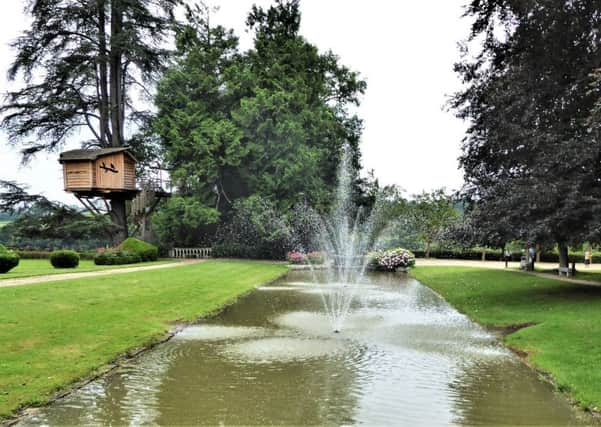Travel review: A feast of culture and history in Bearn


Alexander Dumas was right to set his drama of 1625-28, The Three Musketeers, in Bearn for it enjoys a rich heritage. Lying north of the Pyrenees, it formed part of the Spanish kingdom of Aragon before falling under Gascon rule.
Pau, Bearn’s capital, was the seat of the royal court of Navarre and birthplace of Henry IV of France and the Bourbon dynasty. Today its castle, constructed in 1370, is still impressive with a triple line of defence work. It was later remodelled and houses a stunning range of Flemish and Gobelins tapestries.
Advertisement
Hide AdAdvertisement
Hide AdPau’s elegant 19th century houses and parks derive largely from English visitors who came for the healthy effects of the clean air. An evening stroll through Place Royale, perhaps to dine at Le Majestic, or to take the funicular and eat at Au Fin Gourmet, which is noted for its fish, is delightful.
A driver’s nightmare on account of its pedestrian street closures and constant road repairs, Pau has several underground car parks and makes a good base to discover the region. Hotel Continental is central and offers large-sized rooms.
Two museums should not be missed. The Fine Arts shows Brueghel, Degas, El Greco and Rubens with more modern interpretations. Bernadotte, a former family home, tells a very different story. It relates how a humble soldier was elevated to become Marechal d’Empire in 1780 and, assisted by Napoleon, a royal prince of Sweden. This son of Pau ascended the Swedish throne as Charles XIV in 1818.
The exceptional climate around Pau caused the Wright Brothers to abandon plans to give flying lessons in Le Mans and switch to Pont Long, outside Pau. In 1909 they opened the world’s first flying school on the site which today is the racecourse.
Advertisement
Hide AdAdvertisement
Hide AdBearn offers some novels forms of accommodation. Yurts up to 50 square metres are available at Cuqueron whilst five tree houses (from e133 per night) sleeping up to five are available in the grounds of Chateau de Laas, both west of Pau. Breakfast for the latter is left at the base of each tree.
For a very different experience, Le Prieure is an elegant hotel in the wine village of Madiran, converted from an 11th century Benedictine monastery. It has just six bedrooms and exquisite restaurant whose chef is clearly on course to win a Michelin star.
Madiran is the signature rich red wine of Bearn and appreciated by the pilgrims en route to Santiago de Compostela. It goes well with the region’s many duck dishes.
There is the chance to taste a range of wines, including exquisitely sweet and oddly named Pacherenc du Vic-Bilh, at both the Maison des Vins in a former priory next to the church and at Altema.
Advertisement
Hide AdAdvertisement
Hide AdThis is a landscape of orchards, corn and sunflowers, with villages made from local cobbles, clay and wood. Traditional houses are scallop decorated under the eaves with gabled windows.
Many of the castles are manor houses but raised to rank by their size or architecture. Often they are surrounded by beautiful parks and dovecotes. If you have time to visit only one, do not miss Chateau de Mascaraas, which was reconstructed in the 16th-17th centuries on the base of a Medieval fortress. Its treasures include works by Cranach, Durer and Rembrandt and a library of 1,200 books published between 1493-1815. It has French and Italian gardens. English tours are given (e7).
Nearby is Diusse with one of the most beautiful Romanesque churches in southern France. St Jean-Baptiste has a magnificent interior with an 18th century retable and richly decorated portal. Nearby is an old public washhouse dating from 1901.
A drive south of Pau on the D934 cuts through the pretty Ossau valley whose highest peak rises to over 2,800m. This is the land of the griffon vulture which can be observed from hides in the gorge sides. If you get the timing right, you can see “transhumance” when the shepherds move their flocks to the high mountains for summer.
Advertisement
Hide AdAdvertisement
Hide AdIn the Victorian and Edwardian eras, visitors came for hot spa treatments to the aptly named hamlet of Eaux-Chaudes, a few of which are still available. France’s most famous sartorial headgear, the beret, originated in the Ossau valley and was made in neighbouring Nay which houses a museum on the subject as well as one of the few remaining workshops to create cowbells. Continuing south, discover the Betharram caves. Lying 80m underground, there are 25 caverns which can be reached on foot, by miniature train and by boat.
For a real local feel, visit either Garlin or Lembeye markets. There is a warmth in the hospitality of the local producers. Then continue to watch the activity from a local brasserie whilst enjoying garbure, the local duck, bean and cabbage soup. South of Garlin at Lannecaube lies a snail farm which has guided visits from April to September.
France’s first fortified town was built in Navarrenx in the 16th century. Today its arsenal is an arts centre. Popular for salmon fishing, Navarrenx is most attractive. Its rival for beauty is Salies-de-Bearn whose narrow streets of half-timbered houses form the shape of a snail shell. It was founded on salt and a local works explains the fascinating production.
GETTING THERE
Biarritz is the nearest airport to Bearn, but flights are seasonal. Returns fares from Gatwick with easyJet from £129, and from Stansted with Ryanair from £42.40
Advertisement
Hide AdAdvertisement
Hide AdBordeaux (Merignac airport lies west of the city) has more frequent return flights: easyJet Manchester from £79, easyJet Luton from £51, BA Gatwick from £124
The A64 autoroute runs directly from Biarritz to Pau, capital of Bearn.